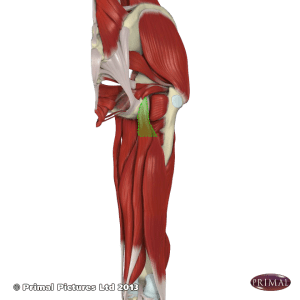High Hamstring Tendinopathy
What is it?
High hamstring tendinopathy refers to a problem within the tendon of the hamstring muscles at the site where they originate from at the pelvis. This site is called the ischial tuberosity and it is the part of the pelvis that we sit on.
How does it happen?
This problem commonly occurs when the activity undertaken exceeds the tendons ability to cope with the load. Activities such as running, especially up hills, are commonly related to this condition. The function of the hamstring origin tendon is to transmit forces produced by the hamstring muscles to the pelvis. When the tendon is subjected to adverse loading the tendon becomes irritated and instigates a chemical reaction within the tendon which may be inflammatory in nature.

How does it feel?
Hamstring origin tendinopathy results in pain felt deep in the lower part of the buttock. This pain typically develops gradually over a period of time. Initially the pain may only be felt following exercise or on rising the day after exercise. Along with pain in the buttock there may also be tightness in the hamstring muscles. If the tendon is particularly aggravated it can be painful to sit on the affected area.The initial signs of this problem are often ignored as they disappear quickly with gentle movement as you warm up. However, as you continue to participate in sport or exercise the problem can progressively worsen and the pain becomes more frequent or intense and is present throughout the duration of activity. This can ultimately interfere with sports performance or limit your ability to participate in exercise.
What should you do?
Initial rest can assist in relieving symptoms however typically on return to your activities the symptoms also return. You can try a graded return to your activities following an initial reduction in training. Sports physiotherapists are well placed to assist in helping you develop a graded return to activity program.
What shouldn’t you do?
If you have hamstring origin tendinopathy then you shouldn’t ignore the problem. You may feel inclined to stretch your hamstrings and gluteal muscles, however it is advised that you avoid this as it can cause further irritation, especially in the early stages. You should try to minimise sitting on hard surfaces and in low seats that cause increased hip flexion (knees to chest).
Could there be any long-term effects?
Hamstring origin tendinopathy usually does not produce any long-term effects if it is properly diagnosed and appropriately treated. Even so, it take a number of months for the problem to resolve with appropriate rehabilitation
Management
The assistance of a sports medicine professional, like the Physiotherapy team at Life Fit Wellness, can be very useful in the treatment of the tendinopathy. We will be able to help confirm your diagnosis and use appropriate treatment techniques to reduce your pain. In addition, we will be able to determine the causes of the issue. Addressing these as your pain settles will help prevent any re-occurrence of the problem when you return to activity. Treatment may involve advice on exercise modification, progressive strengthening, soft tissue techniques and prescription of suitable exercises to improve lumbo-pelvic control and hamstring strength. In resistant or chronic cases, shockwave therapy has good evidence that it helps promote healing and aid recovery.









